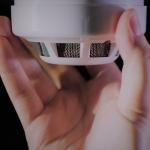
How a Smoke Detector Works
By Complete Electrical Service|February 06, 2023
When a fire starts during the day, you can often smell it and put it out. However, a fire might rob you of the oxygen necessary for breathing if you are sleeping at night. It can also produce poisonous carbon monoxide gas, putting you into a coma that you may never awaken.
What A Smoke Detector Does
Smoke detectors are fortunately available today, thanks to contemporary technology. A smoke detector is crucial for ensuring the safety of your family and home.
A smoke detector is a priceless safety device that may warn you of the possibility of a fire in your home. It quickly alerts you when it detects smoke, heat, or flames so you can take immediate action.
Types of Smoke Detectors
Smoke alarms use two primary forms of technology.
How A Photoelectric Smoke Detector Works
The photoelectric smoke detector has a sensor and a light positioned at 90-degree angles to each other.
Light from the light source usually streams straight across, missing the sensor. However, when smoke goes through the chamber, the smoke particles scatter the light. Some of the light reaches the sensor, activating the alarm in the detector.
They are most effective in detecting smoke-producing fires, like a smoldering mattress.
Pros
Cons
How An Ionization Smoke Detector Works
Smoke detectors that operate using ionization need a small amount of radioactive material. However, the amount is minimal and shielded to prevent irradiation.
This radioactive substance is between two metal plates, charging the air electrically. Smoke entering this region disrupts the electrical current, setting off the alarm. Flame-producing fires often elicit a greater response from ionization smoke detectors.
Pros
Cons
Both smoldering and flaming fires can cause fatalities at any time of day, and it is also impossible to foresee the likelihood of fire and the type of fire that may develop. Therefore, having the two types of smoke detection technologies is the best option. You'll receive fire warnings, regardless of type, time, or when asleep or awake.
Some smoke detectors integrate with smart devices. They send you notifications and assist in monitoring your house while you're away. These smoke detectors also notify you when it's time to replace the batteries.
They employ similar technology as traditional smoke detectors. The distinction is in the other technologies they use for communication.
Conclusion
Both smoke detection technologies are suitable as life-saving fire sensors, despite their functional variations and sensitivity ranges.
In the end, installing a quality smoke detector may be crucial for safeguarding you and your family. Call an electrician to find out what smoke detector is best for you.
What A Smoke Detector Does
Smoke detectors are fortunately available today, thanks to contemporary technology. A smoke detector is crucial for ensuring the safety of your family and home.
A smoke detector is a priceless safety device that may warn you of the possibility of a fire in your home. It quickly alerts you when it detects smoke, heat, or flames so you can take immediate action.
Types of Smoke Detectors
Smoke alarms use two primary forms of technology.
- Ionization
- Photoelectric
How A Photoelectric Smoke Detector Works
The photoelectric smoke detector has a sensor and a light positioned at 90-degree angles to each other.
Light from the light source usually streams straight across, missing the sensor. However, when smoke goes through the chamber, the smoke particles scatter the light. Some of the light reaches the sensor, activating the alarm in the detector.
They are most effective in detecting smoke-producing fires, like a smoldering mattress.
Pros
- Effective for detecting heavy smoke
- Less vulnerable to false alarms such as from shower steam
- They Don't have radioactive substances, thus safer to use.
Cons
- High maintenance costs
- Requires higher current to run. Usually, these detectors need a 110-volt power supply to function.
- Highly sensitive to insects and dust particles, necessitating regular maintenance.
How An Ionization Smoke Detector Works
Smoke detectors that operate using ionization need a small amount of radioactive material. However, the amount is minimal and shielded to prevent irradiation.
This radioactive substance is between two metal plates, charging the air electrically. Smoke entering this region disrupts the electrical current, setting off the alarm. Flame-producing fires often elicit a greater response from ionization smoke detectors.
Pros
- Less expensive compared to photoelectric smoke sensors
- Perform better in detecting rapid flaming fires with little to no visible smoke
Cons
- Highly sensitive and may cause false alarms
- They are less sensitive to smoldering fires
- Concerns about radioactive material use
Both smoldering and flaming fires can cause fatalities at any time of day, and it is also impossible to foresee the likelihood of fire and the type of fire that may develop. Therefore, having the two types of smoke detection technologies is the best option. You'll receive fire warnings, regardless of type, time, or when asleep or awake.
Some smoke detectors integrate with smart devices. They send you notifications and assist in monitoring your house while you're away. These smoke detectors also notify you when it's time to replace the batteries.
They employ similar technology as traditional smoke detectors. The distinction is in the other technologies they use for communication.
Conclusion
Both smoke detection technologies are suitable as life-saving fire sensors, despite their functional variations and sensitivity ranges.
In the end, installing a quality smoke detector may be crucial for safeguarding you and your family. Call an electrician to find out what smoke detector is best for you.



